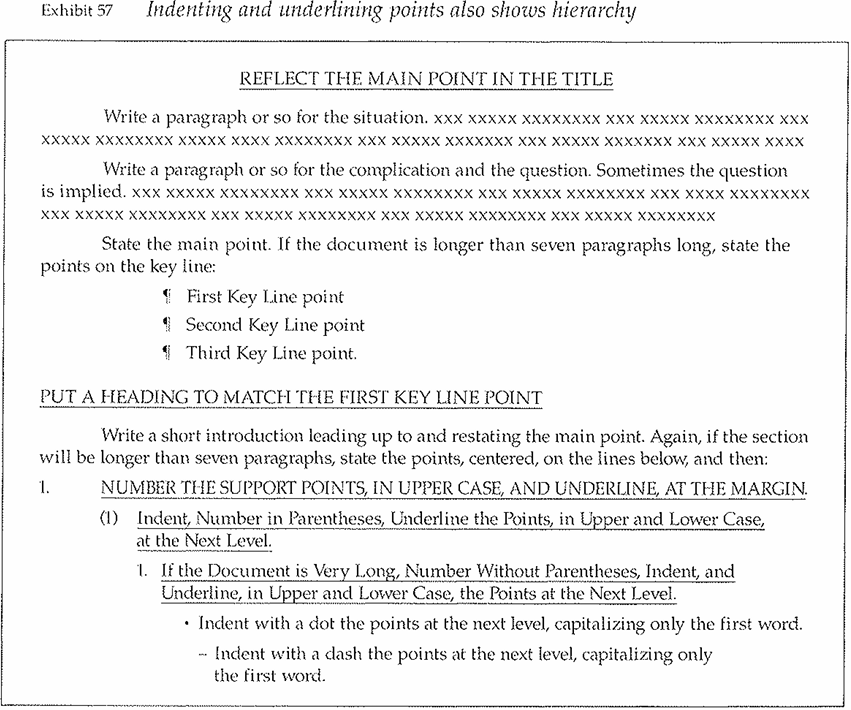
Underlined Points
 المؤلف:
BARBARA MINTO
المؤلف:
BARBARA MINTO
 المصدر:
THE MINTO PYRAMID PRINCIPLE
المصدر:
THE MINTO PYRAMID PRINCIPLE
 الجزء والصفحة:
176-10
الجزء والصفحة:
176-10
 2024-09-28
2024-09-28
 1483
1483
Underlined Points
Another popular approach to showing the hierarchy of ideas is to underline the entire statement of the support points below the Key Line level (Exhibit 57). Lower level support points are also stated in their entirety and underlined, but are distinguished by form and indentation.

This form is rather ugly on the page. The advent of computers has led many people to write the major points in bold type, and leave the underlining to lower level support points, which at least makes for a more attractive page.
1. NUMBER THE SUPPORT POINTS, IN UPPER CASE, AND UNDERLINE AT THE MARGIN.
(1) Indent, Number in Parentheses, Underline the Points, in Upper and Lower Case, at the Next Level.
1. If the Document is Very Long, Number Without Parentheses, Indent, and Underline, in Upper and Lower Case, the Points at the Next Level.
Either way, the stated purpose of the format is to provide speed and ease in reading. The theory is that the reader should be able to zip through if he wishes, reading only the major points, and in that way comprehend the entire message easily. While this may be lovely for the reader, it can be a bit difficult for the writer, because it imposes some strict rules on him.
1. You must be absolutely disciplined in applying question/answer logic. Points below must directly answer the question raised by the point above, and no more. There is no room in this format for graceful liaisons of language or attempts at amplification. Such things destroy the clean, stark presentation of the logic. If you must amplify or give background, you will have to do so in the introductory or concluding paragraphs to each section.
2. You must be careful to word the points so that they stale their message as sparsely as possible. It destroys the ease with which the logic can be comprehended if the reader must wade through 30 words before he grasps the point. If you find yourself with more than a dozen words, or more than one subject and predicate, think again.
3. You must be totally ruthless in limiting your points to the outline of your deductive or inductive argument. Most people disregard this requirement and simply list points, ignoring the niceties of either induction or deduction. You know that there are never more than four points in a chained deductive argument, and never more than five in an inductive one. If you find yourself going beyond, the likelihood is that you have overlooked an opportunity to group, and should rethink what you are saying.
 الاكثر قراءة في Writing
الاكثر قراءة في Writing
 اخر الاخبار
اخر الاخبار
اخبار العتبة العباسية المقدسة


